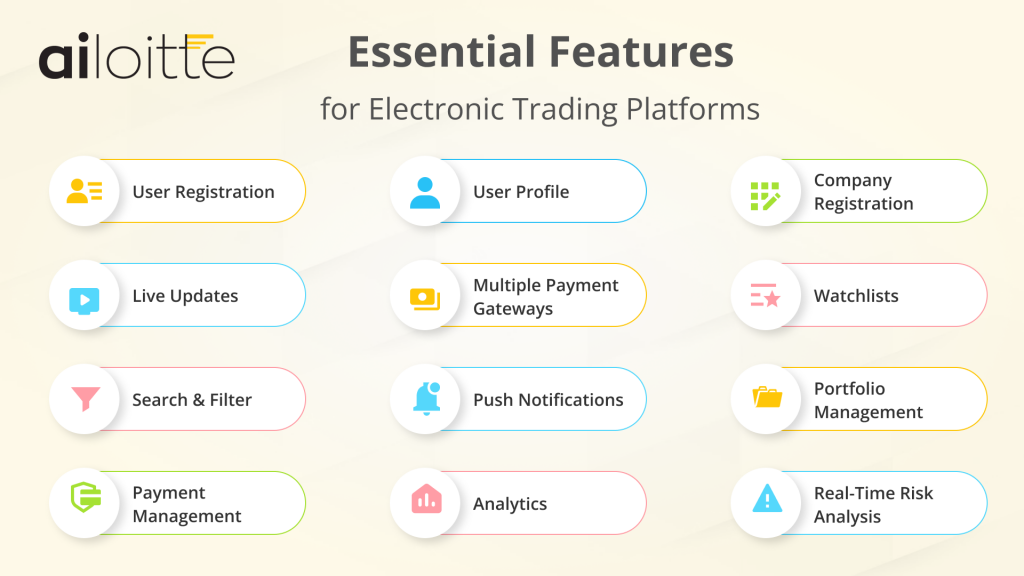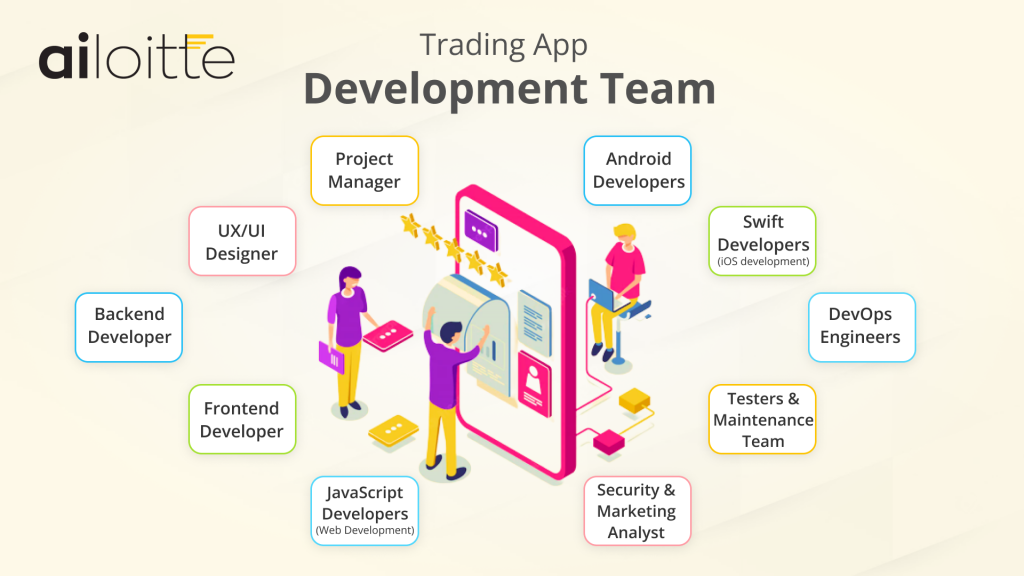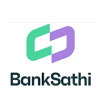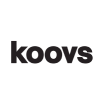Interested in learning how to build trading platform software? Look no further; you’re in the right spot.
The online trading market is expected to grow at a yearly CAGR of 6.4%, reaching 13.3 billion U.S. dollars by 2026 (Statista).

If you’re contemplating developing your stock trading platform and entering this profitable market, continue reading.
The algorithmic trading market also witnessing rapid growth thanks to the advent of Big Data, Artificial Intelligence (AI), and Machine Learning (ML). It’s a financial tech boom in action.

Polaris Market Research reported a global online trading platform value of $9 billion in 2021, while Mordor Intelligence predicts a 10.5% Compound Annual Growth Rate (CAGR) for the algorithmic trading market from 2022 to 2027.
Given this substantial market potential, developing a brokerage app is a lucrative decision. However, it is essential to grasp key aspects of stock trading app development before proceeding.

What is a Stock Trading Platform?
A stock trading platform is a digital interface or software enabling users to buy and sell stocks, bonds, and securities via mobile devices or computers.
These apps offer real-time quotes, news, market analysis, and portfolio management tools. Many also provide educational resources and simulated trading for skill practice without real money risk.
Investors use stock trading platforms to engage in the buying and selling of stocks, aiming to capitalize on market fluctuations and make informed investment decisions.
The accessibility and convenience of these platforms have contributed to the widespread participation of individuals in the financial markets.
Stock trading app development involves designing the user interface, integrating financial data feeds, implementing security measures, and testing for reliability and user-friendliness.
Creating such apps often requires collaboration among software developers, designers, and financial experts to produce a functional and user-friendly product.
This blog will guide you comprehensively on how to develop your own stock trading platform and turn your vision into reality.
Top Trading Platforms
Familiarizing yourself with leading trading platforms provides insights into both the competitive landscape and the essential elements contributing to the success of a trading platform.
- Fidelity
Fidelity offers free stock, options, and ETF trading, and you can open a brokerage account for free. In 2021, they had 83.4 million user accounts, which has been growing quickly since. - TD Ameritrade
TD Ameritrade provides cost-effective funds and an extensive range of investment products, including stocks, mutual funds, bonds, option contracts, forex futures, and ETFs. They have 11 million user accounts. - Charles Schwab
Charles Schwab offers three trading platforms with no registration fees. They provide commission-free stock trading, a wide range of funds, options, and ETFs. Charles Schwab has a total of 33.6 million domestic and international customer accounts. - Ally Invest
Ally Invest offers no-minimum user accounts and allows trading in options, mutual funds, US-listed equities, and ETFs. They have over 250,000 customer accounts with $4.7 billion in assets.
Operating Systems for Online Trading Platforms
To create a trading platform that meets your audience’s needs, it’s advised to develop multiple operating systems to reach a broader user base.

Your user must be able to use your trading platform on operating systems like:
- Windows
- Android
- iOS
- macOS
- Linux
Essential Features for Electronic Trading Platforms

- User Registration
Empower your users with a seamless experience by offering a quick and easy sign-up and sign-in process on your platform.
Unlock convenience by allowing them to register through email, mobile number, or their favorite social media accounts.
Your platform, your rules—simplicity at its finest! - User Profile
Crafting a vibrant user journey, the platform should encourage users to fashion detailed profiles effortlessly, providing a canvas for their financial aspirations.
Seamless updates ensure their evolving needs are met, empowering them to manage and track their financial activities effortlessly.
It should not just be an online trading platform; it’s a personalized space tailored to elevate traders’ financial experience. - Live Updates
Stay in the know with an e-trading platform where traders can receive live updates on the latest changes, events, and breaking news.
Picture this: instant notifications alerting you when a company is on the brink of launching its IPO.
It’s not just about trading; it’s a real-time financial adventure and engagement for your platform’s users at their fingertips! - Multiple Payment Gateways
Empower users with diverse payment options right within the trading platform. Choosing from various trusted and secure payment options, including Stripe, Braintree, PayPal, and Google Pay, ensures flexibility and convenience in every transaction. - Watchlists
This feature will help users create different watchlists of stocks they wish to monitor and buy later. It’s one of the most critical trading platform features. - Search & Filter
Simplify stock discovery within the e-trading platform with the convenience of a search and filter option. This user-friendly feature ensures that finding specific stocks becomes a seamless experience. - Push Notifications
This feature sends notifications to users about important e-trading market news, changes in owned stocks, pending payments, etc. - Portfolio Management
This feature helps users check and manage their portfolios with live updates. - Payment Management
Traders can check information about past or current transactions and deposits. They can also download a statement that provides information about all past transactions on the platform. - Analytics
This feature will help users analyze key financial data from recent and historical trades. Financial reports of all trading activity will help users make better investments and create trading strategies. - Real-Time Risk Analysis
Enable users to skillfully navigate the complexity of risk analysis, guiding them to make well-informed decisions before delving into the realm of company stocks.
How to Create an Online Trading Platform?
Develop an application compatible with Windows, Android, iOS, and macOS, or opt for a focused approach by targeting a specific platform to grow your business with a defined audience.
Here are vital steps to consider for the development of a stock trading app:
- Hire a development team
Embark on the professional journey of launching your trading platform by assembling a team of seasoned professionals skilled in developing trading applications.
Opt for developers with a proven track record in creating investment platforms, making the smart choice to ensure your venture’s success.

Here is a list of personnel you will need for your trading app development:
- Project Manager
- UX/UI Designer
- Backend Developer
- Frontend Developer
- JavaScript Developers (Web Development)
- Android Developers
- Swift Developers (iOS development)
- DevOps Engineers
- Testers & Maintenance Team
- Security & Marketing Analyst
For a cost-effective approach to building an app development team, consider hiring a mobile app development company.
It is always better to go for an experienced offshore company that can handle everything from design and development to testing, launching, marketing, and post-launch support and maintenance.
PRO Tips: When evaluating an offshore development team or company, don’t miss to ask for a demo of their past relevant work. This will ensure they have adequate experience; you can expect a better outcome and on-time delivery.
- Outline your MVP strategy
Craft a stellar debut for your app by starting with a Minimum Viable Product (MVP) – a sleek version featuring only the essential core features.
Experts suggest that when venturing into creating a web or mobile platform for your business, kicking off with an MVP is the ultimate key to success.
It’s not just a launch; it’s a strategic unveiling that sets the stage for brilliance and progressive improvement! - Plan the Security of Your App
When it comes to your users’ financial data, trust is paramount. In the high-stakes world of trading, rock-solid security is not just a feature, it’s the foundation.
Building a secure trading platform isn’t about ticking boxes. It’s about a relentless commitment to security that permeates every aspect of development.
1. Prioritize platform security from the ground up. Implement industry-leading security best practices at every stage, from design and architecture to coding and testing.
2. Go beyond traditional measures. Employ advanced security technologies like multi-factor authentication, end-to-end encryption, and real-time fraud detection to create a multi-layered defense.
3. Build a security-first culture. Foster a team mindset where security is everyone’s responsibility, not just an afterthought.
4. Bring in the experts. Invest in a dedicated security analyst specializing in stock trading app development. Their experience and insights will be invaluable in identifying and mitigating potential vulnerabilities.
Remember, trust is earned, not given. By making security your top priority, you’ll build a trading platform that users can confidently rely on and trade after trade.
- Monitor & Get Involved in Development Process
Staying vigilant during stock market app development is vital to catching and rectifying mistakes in real-time. This saves you time, money, and user frustration down the line.
Work closely with business analysts to prioritize core features and to ensure flawless performance of critical features like Buy, News Feed, Search, Risk Analysis, Sell, Manage Payment, and Withdraw. Make them instantly accessible and intuitive to avoid user confusion and friction.
Participate in the design phase and ensure the design of an appealing user interface to capture and retain user attention effectively. - Choose Technology Stacks
Selecting the right technology stacks is crucial for the seamless operation of your trading platform.
Find a solution architect who has good expertise in architecting trading platforms and is capable of choosing the optimal tech stacks tailored to your platform’s needs.

Here are some general considerations for different sections of the tech stack for trending app development:
Backend:
- Programming languages: Python (Django, Flask), Java (Spring Boot), Node.js (Express.js)
- Databases: PostgreSQL, MySQL, MongoDB
- Messaging queues: RabbitMQ, Kafka
- Financial data APIs: IEX Cloud, Alpaca, Polygon.io
Frontend:
- Mobile frameworks: React Native, Flutter, Swift (iOS), Kotlin (Android)
- Web frameworks: React, Vue.js, Angular
- UI libraries: Material UI, Ant Design, Chakra UI
Cloud Infrastructure:
- AWS: Amazon Web Services offers a wide range of services for building and deploying cloud applications.
- Microsoft Azure: Azure provides similar services to AWS, with a focus on enterprise users.
- Google Cloud Platform: GCP offers competitive pricing and integration with Google services.
The ideal tech stack is not a one-size-fits-all solution. By carefully considering your specific needs and constraints, the solution architect can build a platform that is reliable, scalable, and secure for your online trading app.
- Prioritize Proactive Testing
In the world of trading apps, where money is on the line and every second matters, testing isn’t just a step—it’s the bedrock of trust and success.
Here’s why rigorous testing is indispensable for trading app development:
1. Protecting User Assets and Reputation:
Prevent Costly Bugs and Vulnerabilities: Undetected flaws can lead to financial losses, data breaches, and irreparable damage to your reputation. Testing acts as a safeguard, catching issues before they impact users.
2. Ensuring Flawless Functionality:
Guarantee Smooth Transactions and Decisions: Every feature, from order execution to market data updates, must work flawlessly under pressure. Testing verifies accuracy and reliability, ensuring users can trade with confidence.
3. Optimizing Performance and User Experience:
Deliver Speed and Satisfaction: Traders demand lightning-fast execution, intuitive navigation, and a seamless experience. Testing identifies performance bottlenecks and usability issues, resulting in a polished and responsive app.
4. Meeting Regulatory Compliance:
Align with Financial Standards: Trading apps are subject to strict regulations regarding data security, privacy, and financial integrity. Comprehensive testing ensures compliance and can prevent costly legal repercussions.
5. Building User Confidence and Trust:
Establish Credibility and Loyalty: A well-tested app demonstrates your commitment to quality and security, fostering trust and long-term user loyalty in a competitive market.
Testing is an ongoing process, not a one-time event. Continuously test and refine your trading app to maintain its integrity, stay ahead of evolving threats, and deliver an exceptional experience that keeps users coming back for more.
- Discuss Your Objectives with the Marketing Expert
A solid marketing strategy is the key to making your online brokerage platform stand tall.
Communicate your platform goals to your marketing expert to craft a strategy that appeals to your target audience.
A professionally executed marketing approach enhances the performance of a well-developed trading platform even further. - Launch and Post-Launch Support
The journey doesn’t end after figuring out how to build a stock trading app. Plan the launch with the expertise of a seasoned professional and then shift focus to post-launch support and maintenance.
It’s crucial to have a development team experienced in building and maintaining trading platforms, as ongoing updates and bug solutions are inevitable for both web and mobile versions.
The post-launch support team ensures the platform remains functional for users by addressing any issues that may arise.
Also Read: How To Build a FinTech App
Consider the Legalities of Trading Application Development
Before venturing into the stock market app arena, navigate the legal landscape!
Consider the following legal requirements as you delve into stock market app development:
- US Securities and Exchange Commission (SEC)
The SEC safeguards investors from fraud and ensures fairness in outcomes. Your trading platform must comply with and adhere to US securities laws enforced by the SEC. - Financial Industry Regulatory Authority (FINRA)
Ensure your trading business aligns with FINRA, which regulates Broker-Dealers, Funding Portals, and Capital Acquisition Brokers, safeguarding American investors. - Chicago Board Options Exchange (CBOE)
Ensure your electronic trading platform complies with the Chicago Board Options Exchange (CBOE), the world’s largest options exchange. CBOE offers a range of products, including US and European equities, options, futures, multi-asset volatility products, exchange-traded products (ETPs), and global foreign exchange (FX). - National Futures Association (NFA)
The National Futures Association (NFA) safeguards investors and markets by regulating various entities like brokers, commodity pool operators, swap dealers, futures merchants, exchanges, and commodity trading advisors. Ensure your trading platform aligns with the rules and regulations of the NFA.
Cost Structure to Build a Stock Trading Platform

Several factors, such as features, app design, and the app developer’s location, influence the development cost of your platform. Developers with expertise in creating stock market apps for Android, iOS, and Windows can provide estimates.
Developing an MVP trading app may cost between $30,000 to $40,000, while a complex/multi-feature app could range from $45,000 to $65,000.
Recommended Section: App Development Cost: The Definitive GuideTrading App Development Cost
| Platforms | MVP | Complex (Multi-Feature) |
| Android | $30,000 to $40,000 | $45,000 to $65,000 |
| iOS | $40,000 to $45,000 | $55,000 to $70,000 |
| Windows | $35,000 to $40,000 | $50,000 to $60,000 |
| Web App | $35,000 to $40,000 | $50,000 to $60,000 |
| MacOS | $35,000 to $40,000 | $50,000 to $60,000 |
Conclusion
Jump on the creation of a trading app is no small feat—it’s a huge project demanding intricate logic, robust architecture, and the perfect blend of technology, features, and speed to define its success.
In our Article, we’ve meticulously tackled your quest for “how to develop stock market platform,” resolving the development process, operational intricacies, essential features, and lucrative monetization strategies.
For those aspiring to craft a stellar stock trading mobile app, the key lies in opting for a tailored fintech app development journey.
Enlist the expertise of a dynamic stock trading app development company like Ailoitte to create an app that not only enters but dominates the market. Let our ingenious stock market app developers guide you on the path to your aspirations.
It’s not just app development; it’s about sculpting a masterpiece that stands out in the dynamic world of finance.
Frequently Asked Questions
The rough estimate of the trading platform development cost (Android/iOS/Windows) is between $50,000 to $60,000. But the development cost may go lower or higher with your feature requirements and design goals for the trading platform.
The average cost of developing an MVP version of an app like Robinhood is between $20,000 to $40,000. The development cost can go beyond $45,000 for a complex app.
Here are the professionals you need to make a broker app:
1. Project Manager
2. UX/UI Designer
3. Backend Developer
4. Frontend Developer
5. JavaScript Developers (Web Development)
6. Android Developers
7. Swift Developers (iOS development)
8. DevOps engineers
9. Testers & Maintenance Team
10. Security & Marketing Analyst
You can either hire an onshore app development team. Or hire offshore developers to get better options with the development cost.
It takes approximately 4-8 months to build the advanced version of the trading platform apps. The MVP version takes less than 2 to 3 months.
Here is a list of data sources for the trading app:
1. Financial Exchanges:
a. Direct feeds: Access real-time and historical data directly from major exchanges like NYSE, Nasdaq, and LSE. This offers the most accurate and granular data but often costs more.
b. Exchange APIs: Many exchanges offer programmatic access to their data, allowing for easier integration into your app.
2. Financial Data Aggregators:
a. IEX Cloud: A popular option known for its high-quality market data and low latency. They offer historical and real-time data for stocks, options, and other financial instruments.
b. Alpaca Markets: Provides free basic access to real-time and historical data for US stocks, along with paper trading functionality. Offers more advanced features with paid plans.
c. Polygon.io: Delivers real-time and historical data for stocks, options, forex, and cryptocurrencies. Their API boasts ease of use and scalability.
3. Alternative Data Providers:
a. Quandl: Offers an extensive dataset of alternative data, including satellite imagery, economic indicators, and news sentiment analysis, which can provide unique insights into market movements.
b. Intrinio: Specializes in alternative data sets like SEC filings, company financials, and market news, allowing for fundamental analysis within your app.
4. News and Sentiment Analysis Tools:
a. Reuters News API: Access real-time and historical news articles from a trusted source, allowing your app to incorporate news analysis and sentiment detection for informed trading decisions.
b. Google Cloud Natural Language API: Analyze the sentiment and language of news articles or social media feeds to uncover market trends and investor opinions.
5. Social Media Monitoring Tools:
a. Twitter API: Track investor sentiment and trending topics on Twitter to gauge market sentiment and identify potential catalysts for price movements.
b. StockTwits: A social media platform specifically for traders and investors, offering valuable insights and discussions about individual stocks and market trends.
Choosing the best data source for your app depends on your specific needs and budget. Consider factors like data accuracy, latency, cost, coverage, and the types of data you need. You may also combine data from multiple sources for a more comprehensive view of the market.
User Experience and User Interface. These features create a unique experience for customers through your app.
Your trading platform will get more users every day if the user experience and interface are appealing, user-friendly, and convenient.
Leave a Reply
Hire an Experienced Trading App Development Team
Get your app on time and within budget


















.png)
.png)
.png)



Leave a Comment